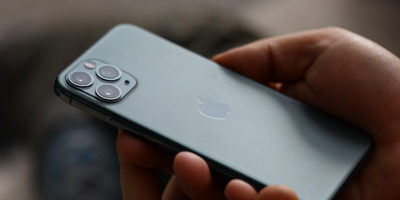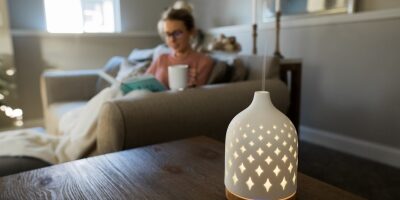
Deciding exactly where to place a humidifier in your bedroom and around your home can be confusing. Especially when the instruction manual doesn’t include enough information on this topic.
You’re probably wondering if it’s safe to sleep with a humidifier and if it will cause any damage to your room. In this article, we will give you some guidelines to follow when positioning a humidifier at home to help you create a healthy environment for you and your family.
Since bedrooms are usually smaller, it is important to remember that ultrasonic units can cause condensation if they’re overused. Excessive humidity from a humidifier can lead to dampness and eventually mold, particularly on soft furnishings or wooden surfaces in confined spaces. While this might make you consider using an evaporative model instead, ultrasonic humidifiers run quieter and are therefore better suited to a sleep environment. Some ultrasonic models also include humidistats which shut the unit off when the air reaches the desired humidity level, limiting the likelihood of over-humidifying your room. A built-in humidistat is an essential feature to look for when selecting a humidifier.
If you’re still deciding which humidifier is the best one to buy for your bedroom, click here to see our humidifier reviews to help you choose the most suitable model.
Where to Put a Humidifier

Keeping a humidifier in your bedroom at night may help with encouraging a more peaceful and deep sleep as it works to increase the moisture in the air. But exactly how close should a humidifier be to your bed?
It is best to place the humidifier at least 3 feet away from your bed. This is to avoid being directly exposed to too much moisture and to allow the moisture to be distributed evenly around the room.
Another advantage of keeping a humidifier 3 feet away is to avoid being woken by the gurgling, the motor and other sounds that humidifiers can sometimes make.
Some humidifiers also have a bright light or display which you may also find distracting if it is too close when you are trying to get to sleep.
If you are sick and feeling very congested, you could temporarily move a warm mist humidifier closer to your bed to reap the benefits of the hot steam in the air which can help open air passageways in the nose and throat.
Place the humidifier in the part of the room you want to humidify the most as the area of the room closest to your humidifier will be the most affected.
Just make sure your humidifier is at least 1 foot away from all walls, furniture, curtains, and electrical appliances and ensure the mist nozzle is pointing towards the center of the room. This distance is recommended to help avoid potential water damage that can occur as the mist settles and condenses on surfaces overnight.
Elevate your ultrasonic humidifier at least 2 feet from the ground on a desktop or nightstand with a tray or other water-resistant cover underneath if possible. This height allows the water steam or vapor to reach higher into the air and be distributed around the room more efficiently. It also avoids the issues of mist from an ultrasonic humidifier puddling on the floor overnight. The elevated height will give the water vapor enough time to evaporate in the air before reaching the ground. If you are planning on using an evaporative humidifier in your bedroom, you can put it on the ground but ensure there is a water-resistant tray underneath in case of a spillage. Do not place your humidifier on or close to wooden surfaces or carpet where water damage could occur without protection. And always opt for a flat surface to further prevent the risk of spillage.
Do not place your humidifier on or near any heat sources such as a furnace, heater, stove, or direct sunlight.
Do not place your humidifier in a position where the mist is directly hitting a thermostat. As the air being expelled by the humidifier will affect the accuracy of your thermostat’s reading.
Should a Humidifier Be on the Floor or a Nightstand?
Ultrasonic humidifiers work by emitting microscopic droplets of water into the air. Over time, this can cause water to settle and pool on surfaces around the humidifier. Because of this, ultrasonic humidifiers should always be placed at least 2 feet above the floor to protect your floors from getting wet. This elevated height gives the droplets enough time to evaporate in the air before reaching the ground.
We recommend using a sturdy nightstand or table but remember to use a water-resistant tray under your humidifier to also protect your furniture and collect any potential water residue.
If you prefer to use an evaporative humidifier in your bedroom, it is fine to place it on the floor as it won’t produce condensation. However, a water-resistant tray underneath is still recommended in case of accidental water spills.
Don’t forget that if you choose to place your humidifier on a nightstand, it should be at least 3 feet away from your bed.
Where to Place a Humidifier in a Baby’s Room

When using a humidifier in a baby’s room, similar rules apply. These include:
- Ultrasonic humidifiers are generally better for the bedroom than evaporative humidifiers as they are much quieter when operating.
- Place the humidifier approximately 6 feet away from the crib to avoid direct contact between the mist and your child.
- Place the humidifier in the area of the room you want to humidify the most and with the mist nozzle pointing in the same direction.
- Elevate your ultrasonic humidifier at least 2 feet from the ground with a water-resistant tray underneath.
- Do not put your humidifier on or close to wooden surfaces or carpet where water damage could occur without a protective cover.
- Do not place your humidifier on any heated or warm surfaces such as on top of a heater.
- Place your ultrasonic humidifier at least 1 foot away from all walls, furniture, curtains, and other electronic appliances and point the mist nozzle into the middle of the room.
But there are some additional guidelines to follow when using a humidifier around babies. For instance, for safety reasons, it is best not to use warm mist humidifiers to avoid accidental burns. You should also leave your baby’s bedroom door at least partially open to ensure there is no over-humidification of the room.
Placement of a humidifier in a baby’s room is critical, especially as babies turn into curious toddlers. Ensure both the humidifier unit and its electrical cords are placed well out of baby’s reach and on a sturdy high surface (such as a chest of drawers or shelves bolted to the wall) so that your little one cannot pull the unit down.
Cleanliness is also critical when using a humidifier in your baby’s bedroom. Clean your humidifier twice a week by wiping it down with a soft cloth and a mixture of white vinegar and water. It’s also essential to change the water before each use to help eliminate any bacteria or mold that may have built up.
Using filtered or distilled water in your baby’s humidifier may also help avoid white dust, which can be an irritant on sensitive babies’ lungs. It’s also important to note that humidifiers may not be safe to use around infants and small children who are prone to asthma or respiratory illnesses.
Is It Safe to Sleep with a Humidifier in Your Bedroom?
When you first start using a humidifier in your bedroom, keep a close check on how your body and the environment around you is reacting. Remember to keep your humidifier clean and to monitor the humidity levels in your room to avoid over-humidification and achieve the ideal humidity for sleeping. One of the potential side effects of adding too much moisture indoors is that you increase the risk of mold and bacteria.
Ultrasonic humidifiers are often recommended for use in the bedroom while sleeping because of their lower noise emissions. However, they can over-humidify a room as the microscopic water droplets can pool and make things wet (increasing the likelihood of mold forming). If you see this start to happen, you may prefer to opt for an evaporative humidifier. Evaporative humidifiers use the natural process of evaporation to add moisture to the air, so they don’t produce any condensation on floors or other surfaces.
Ensure you keep your unit clean by changing the water before each use and by wiping the inside down regularly (ideally twice a week) using a soft sponge with a mixture of white vinegar and water. According to the Consumer Product Safety Commission (CPSC), “breathing dirty mist may cause lung problems ranging from flu-like symptoms to serious infection.”
Another potential hazard to be mindful of when using an ultrasonic humidifier during your sleep is white dust. This dust is caused by the mineral deposits in tap water that are left behind after the mist lands on furniture or other surfaces and dries up. White dust can potentially be an issue for anyone with allergies, asthma, sinus or lung health conditions, particularly infants and small children. To prevent white dust, use distilled water that does not contain any mineral content.
When Should You Use a Humidifier in Your Home

The purpose of a humidifier is to increase humidity levels by adding moisture to the air. So a humidifier is going to be most effective if the air in your home is causing you discomfort because it’s overly dry.
The Environmental Protection Agency (EPA) suggests that the humidity level inside a home should be kept below 60% and ideally between 30% to 50%. Anything below 30% can cause health issues such as sinus irritation, dry skin, or nosebleeds (see our humidifiers for bloody noses here). In comparison, anything above 60% increases the likelihood of other hygiene issues, such as bacteria and mold.
Signs that your home may need more humidity include more than just irritated dry skin and nosebleeds. Overly dry air can even damage wooden furniture and floorboards. You can read more about how to identify the symptoms of dry air in your home here.
To check the humidity levels inside your home, use a digital hygrometer. Even a budget indoor hygrometer will provide a quick and precise reading. You can find out more about the best hygrometers for home use in our buying guide.
Final Thoughts
When deciding the best place to put your humidifier, consider where the unit can give the most benefit while not damaging your soft furnishings, carpet, or electrical equipment.
Since evaporative humidifiers tend to be noisier but more powerful, it makes sense to use these types of models in larger living areas where the additional noise won’t be so bothersome. While an ultrasonic humidifier is generally quieter and better suited in bedrooms, they do run the risk of over-humidification, and they can produce annoying white dust. Thus, monitoring humidity levels and regularly cleaning your humidifier is key to a healthy indoor environment.




